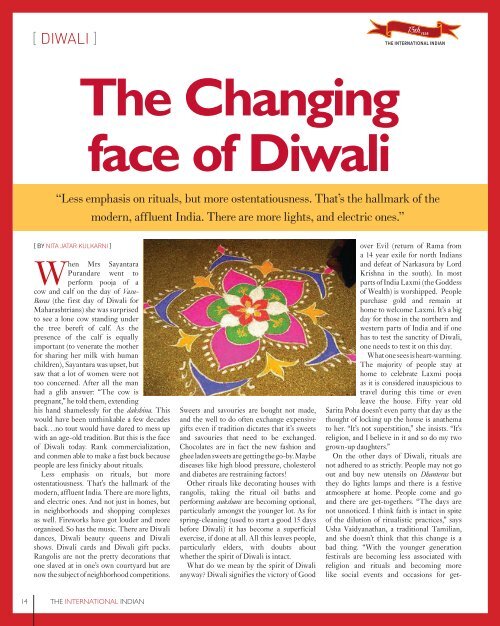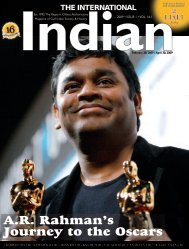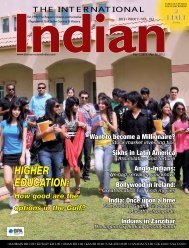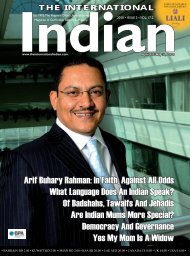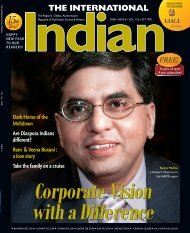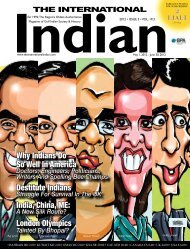THE BUSINESS OF EDUCATION - International Indian
THE BUSINESS OF EDUCATION - International Indian
THE BUSINESS OF EDUCATION - International Indian
Create successful ePaper yourself
Turn your PDF publications into a flip-book with our unique Google optimized e-Paper software.
[ DIWALI ]<br />
The Changing<br />
face of Diwali<br />
“Less emphasis on rituals, but more ostentatiousness. That’s the hallmark of the<br />
modern, affluent India. There are more lights, and electric ones.”<br />
[ By NITA JATAR KULKARNI ]<br />
When Mrs Sayantara<br />
Purandare went to<br />
perform pooja of a<br />
cow and calf on the day of Vasu-<br />
Baras (the first day of Diwali for<br />
Maharashtrians) she was surprised<br />
to see a lone cow standing under<br />
the tree bereft of calf. As the<br />
presence of the calf is equally<br />
important (to venerate the mother<br />
for sharing her milk with human<br />
children), Sayantara was upset, but<br />
saw that a lot of women were not<br />
too concerned. After all the man<br />
had a glib answer: “The cow is<br />
pregnant,” he told them, extending<br />
his hand shamelessly for the dakshina. This<br />
would have been unthinkable a few decades<br />
back…no tout would have dared to mess up<br />
with an age-old tradition. But this is the face<br />
of Diwali today. Rank commercialization,<br />
and conmen able to make a fast buck because<br />
people are less finicky about rituals.<br />
Less emphasis on rituals, but more<br />
ostentatiousness. That’s the hallmark of the<br />
modern, affluent India. There are more lights,<br />
and electric ones. And not just in homes, but<br />
in neighborhoods and shopping complexes<br />
as well. Fireworks have got louder and more<br />
organised. So has the music. There are Diwali<br />
dances, Diwali beauty queens and Diwali<br />
shows. Diwali cards and Diwali gift packs.<br />
Rangolis are not the pretty decorations that<br />
one slaved at in one’s own courtyard but are<br />
now the subject of neighborhood competitions.<br />
Sweets and savouries are bought not made,<br />
and the well to do often exchange expensive<br />
gifts even if tradition dictates that it’s sweets<br />
and savouries that need to be exchanged.<br />
Chocolates are in fact the new fashion and<br />
ghee laden sweets are getting the go-by. Maybe<br />
diseases like high blood pressure, cholesterol<br />
and diabetes are restraining factors!<br />
Other rituals like decorating houses with<br />
rangolis, taking the ritual oil baths and<br />
performing aukshans are becoming optional,<br />
particularly amongst the younger lot. As for<br />
spring-cleaning (used to start a good 15 days<br />
before Diwali) it has become a superficial<br />
exercise, if done at all. All this leaves people,<br />
particularly elders, with doubts about<br />
whether the spirit of Diwali is intact.<br />
What do we mean by the spirit of Diwali<br />
anyway? Diwali signifies the victory of Good<br />
over Evil (return of Rama from<br />
a 14 year exile for north <strong>Indian</strong>s<br />
and defeat of Narkasura by Lord<br />
Krishna in the south). In most<br />
parts of India Laxmi (the Goddess<br />
of Wealth) is worshipped. People<br />
purchase gold and remain at<br />
home to welcome Laxmi. It’s a big<br />
day for those in the northern and<br />
western parts of India and if one<br />
has to test the sanctity of Diwali,<br />
one needs to test it on this day.<br />
What one sees is heart-warming.<br />
The majority of people stay at<br />
home to celebrate Laxmi pooja<br />
as it is considered inauspicious to<br />
travel during this time or even<br />
leave the house. Fifty year old<br />
Sarita Poha doesn’t even party that day as the<br />
thought of locking up the house is anathema<br />
to her. “It’s not superstition,” she insists. “It’s<br />
religion, and I believe in it and so do my two<br />
grown-up daughters.”<br />
On the other days of Diwali, rituals are<br />
not adhered to as strictly. People may not go<br />
out and buy new utensils on Dhanteras but<br />
they do lights lamps and there is a festive<br />
atmosphere at home. People come and go<br />
and there are get-togethers. “The days are<br />
not unnoticed. I think faith is intact in spite<br />
of the dilution of ritualistic practices,” says<br />
Usha Vaidyanathan, a traditional Tamilian,<br />
and she doesn’t think that this change is a<br />
bad thing. “With the younger generation<br />
festivals are becoming less associated with<br />
religion and rituals and becoming more<br />
like social events and occasions for get-<br />
14<br />
<strong>THE</strong> INTERNATIONAL INDIAN


